(english is not my native tongue and it's pretty late).
I am facing a problems for some days and, after many not successfull attemps, I decided to come here to have some help or at least a direction.
We will talk about dithering and color banding. I will not try to explain here what are these, I will just assume that the reader already knows.
Ok, let's start with a picture
On this image, there is no dithering. Color bands are easy to see, if not on the wall at least on the floor. Because I am generating this image, I do have access to higher precision for each pixel during the generation. If a channel is an integer from 0 to 255, I do have access to values likes 5.24 (the important thing is ".24" - this is what I mean by a "higher precision"). My original idea was to use a noise based on the pixel's position on screen. If we assert that the noise yield values between 0 and 1, for 5.24 the algorithm would looks like
if ( noise(x,y) < 0.24 ) color = 6 else color = 5
I was also using a "white noise" and I obtained this result

It's a lot smoother, but we get a very high noise. Plus, there is still color banding and this will be the problem I have. By replacing the white noise by a "blue noise", I get this last image
Which is a lot better for the noisiness of the resulting image but ... there are still color bands.
I tried to figure out why. I think it's because I use what I would call a "linear split" or "linear gradient" or "linear interpolation" ... or "linear" something, but it's linear. It the formula I already gave
if ( noise(x,y) < 0.24 ) color = 6 else color = 5
If it's not 0.24 but 0.5, it means a 50/50 mix of (5,5,5) and (6,6,6). However, such and image will appear closer to (6,6,6) than to (5,5,5). Somehow, I think that it's wrong to think that the step between (0,0,0) and (1,1,1) is the same than the step between (200,200,200) and (201,201,201). I think it shouldn't be thought as an addition but as a ratio. And the formula above doesn't really take the "5" into account (it will behave the same way for 5.24 and 200.24).
I don't know if I explain myself well, and it's already really late.
To summerize, I am looking for a formula taking into account not only the ".24" part not only the position of the pixel but also the "5" part.
I think that there is an exponential somewhere (because there is always exponential in optic) and that the result will depend on the monitor (and what I am looking for is more related to cymk than to rgb).
But, still, is there something I can do ? Is there a name to this "non-linear increase of the value of the color" ? Is there something I can ask to google ?
Thanks a lot.

